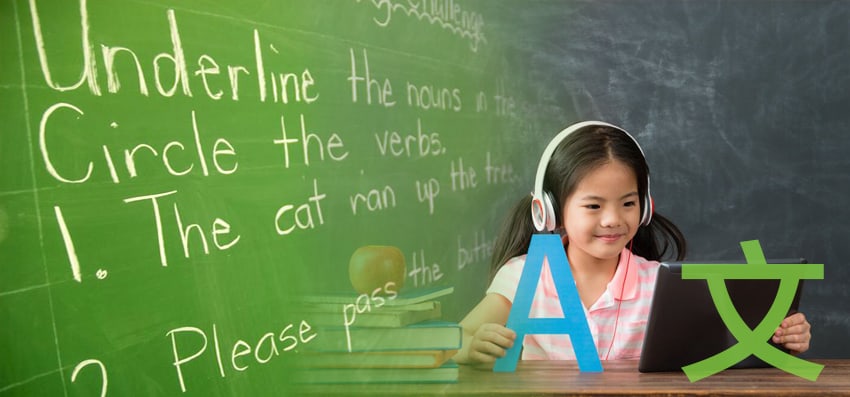In our first article, we looked at the basic characteristics of English and Chinese and learnt about how the two might differ in terms of sentence structure. With this in mind, join us as we continue to explore their differences and look some examples of translations to see what translators have to be aware of in the course of their work.
Accuracy > Localisation (?)
Have you ever looked at a translation and thought to yourself, “That’s not right!”? This is often the result of simply translating what is seen in the source without any consideration for the translation.
Consider the following examples:
| Source | Possible Translation 1 | Possible Translation 2 | |
| 1 | 我每天在家上班。 | I every day at home work. | I work at home every day. |
In Example 1, it is quite clear that the words have to be rearranged during translation to satisfy the grammatical requirements for sentence structure in English. The translator first has to consider the relationship between the various components of the sentence and then decide on the arrangement to adopt.
| 2 | 公众即日起进入四座指定巴刹,如芽笼士乃和忠邦巴刹时,身份证尾号若不符合单双日规定,工作人员不再“放行”。
– Lianhe Zaobao, 24 Apr 2020 |
The public will enter the four designated Bazaars from now on, such as Geylang Serai and Chung Bang Bazaar. If the tail number of the ID card does not meet the requirements of single and double days, the staff will no longer “release”. | From today onwards, when members of the public enter the four designated markets, such as Geylang Serai Market and Chong Pang Market, they will be denied entry if the last digit of their identity card does not meet the odd-even day requirements. |
Translation can get even more complication when complex sentences are encountered. In Example 2, the key concept is that “from today onwards, members of the public will be denied entry if…” Hence, having the time indicator, “from now on”, appearing only towards the end of the first half of the sentence, affects the meaning and reduces the emphasis on the timing. If you contrast this with Possible Translation 2, where this information is brought to the start of the sentence, it becomes clear that the emphasis is on the time, i.e. from today onwards.
As with the first half of the sentence, the last 2 clauses have also been rearranged to emphasize the change that has taken place “from today onwards”, i.e. that members of the public will be denied entry. Furthermore, as the main subject of this sentence is the members of the public, they have been kept as the main subject in the second half of the sentence. Hence, the action has been changed to something that is done to them, rather than an action that was done by the staff.
| 3 | Fans of local television have to be prepared for a delay in new content as circuit breaker measures have shut down much of Singapore’s media industry.
– The Straits Times, 23 Apr 2020 |
由于断路器措施已经关闭了新加坡大部分媒体行业,本地电视迷必须为新内容的延迟做好准备。 | 随着阻断措施导致新加坡媒体界大部份不得不暂停营业,本地电视迷必须为新节目的延迟播出做好心理准备。 |
In Example 3, the order of the clauses has been interchanged in the Chinese translation, with the cause being moved up to the front of the sentence. This change allows for a more natural flow to the sentence in Chinese, as Chinese sentences generally present information to reflect cause-effect, and a sequence of events.
Additionally, the words marked out in red also reflect words that have a local context. For example, “circuit breaker” here refers to a set of Government measures that were put in place to combat the COVID-19 pandemic. Hence, it is more accurately translated as “阻断措施“ (lit. blocking measures) in the Possible Translation 2 column, rather than as the literal “断路器”, which refers to the physical device used to break an electrical connection. Hence, it is important for translators to know the context of the languages that they translate in. This not only applies to the language itself, but also to the region where the language is used. If someone without knowledge of the Singapore context were to translate it, the end result might ring unfamiliar to a local audience.
As you can see, when translating between 2 languages, translators not only has to know the languages they are working with, but they must also be able to discern when to rearrange the content they are translating. By doing so, they will be better able to render translations that are not alien to the target audience. Furthermore, they should also have knowledge of the context within which they are translating.
Of course, the examples provided above are not exhaustive. Now that you have idea of what translators have to go through and take note of when translating from one language to another, hopefully you will be able to better appreciate brilliant translations when you come across them the next time.
We are not quite done yet though. Stay tuned for the last article in the series where we learn about how sentences are formed in both English and Chinese.
Find out more about how Lingua Technologies can better support your translation requirements not just in English and Chinese, but also in a wide range of languages ranging from Asian, European to Middle Eastern and Nordic languages. Visit https://www.translationsingapore.com/ or send your enquiries to inquiry@translationsingapore.com.

